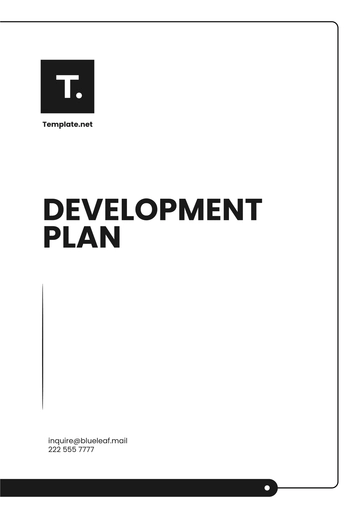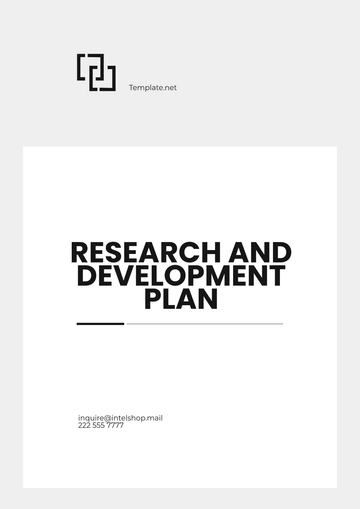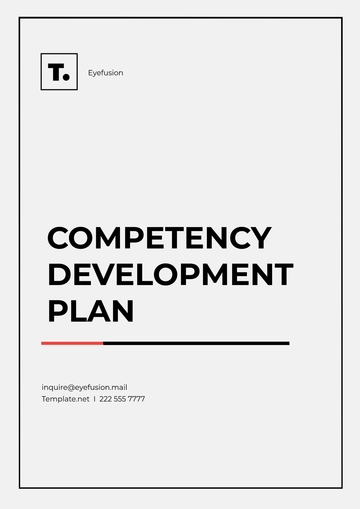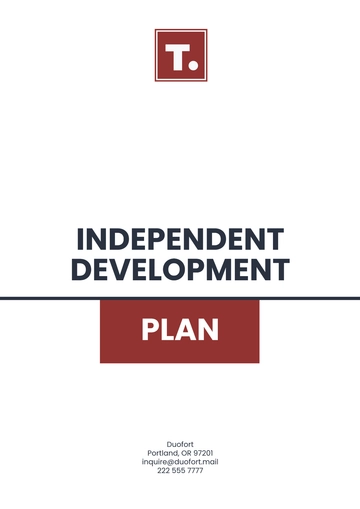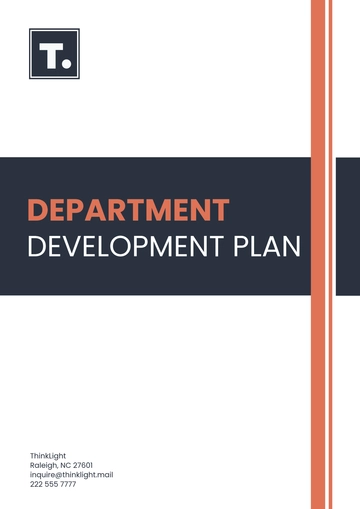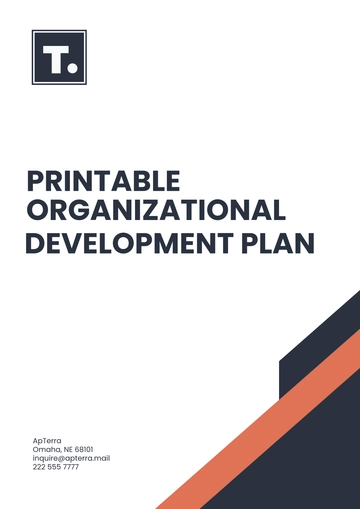Free Agriculture Innovation Plan
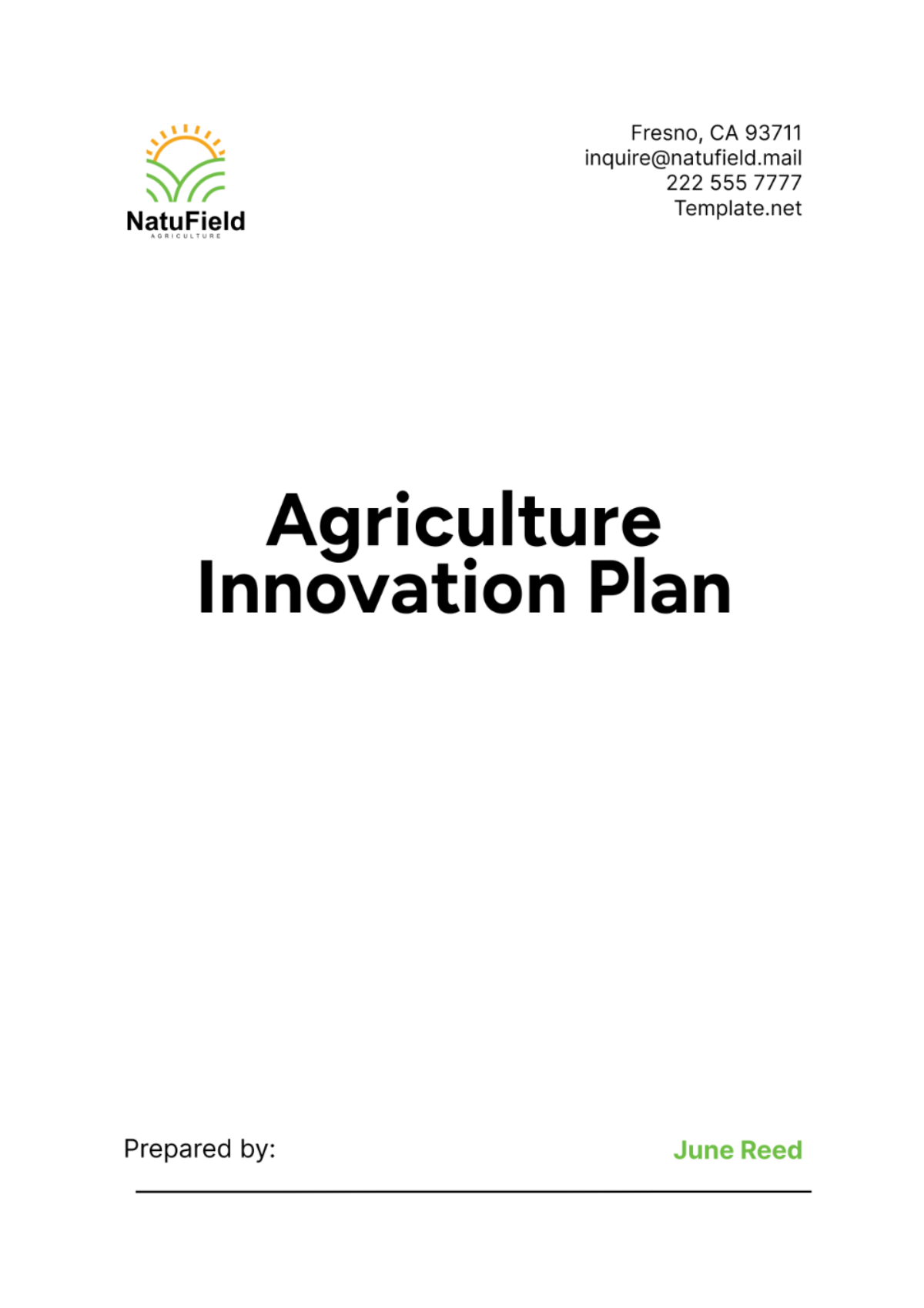
I. Objective
The Agriculture Innovation Plan at [Your Company Name] is strategically designed to significantly enhance crop yields through the integration of sustainable practices and cutting-edge technologies. By leveraging precision agriculture methodologies, including advanced data analytics and IoT sensor networks, we aim to optimize resource efficiency and reduce environmental impact. Our commitment extends to pioneering sustainable farming practices that not only bolster profitability but also ensure responsible stewardship of natural resources. Through continuous research and strategic partnerships, [Your Company Name] endeavors to set new benchmarks in agricultural innovation, fostering resilience and productivity in farming communities while addressing global food security challenges.
II. Key Strategies
Explore [Your Company Name]'s strategic approach to agricultural innovation. Our focus on precision agriculture integrates advanced data analytics and IoT sensor technologies for optimized resource management. Through robust R&D efforts, we develop tailored seed varieties to enhance crop resilience and productivity. Collaborations with leading tech firms drive AI and machine learning applications, revolutionizing crop management with predictive analytics.
A. Precision Agriculture Techniques
We prioritize precision agriculture techniques such as data-driven decision-making and IoT sensor applications to optimize resource allocation.
Precision Agriculture Techniques | Details |
|---|---|
Data-Driven Decision-Making | Utilize advanced data analytics to collect and analyze real-time and historical data on weather patterns, soil health, and crop growth. This enables informed decision-making in planting, irrigation, and nutrient management, optimizing resource use and enhancing yield. The data-driven approach also includes the integration of satellite imagery and weather forecasts to anticipate changes and adapt farming practices accordingly, ensuring proactive risk management and maximizing crop resilience. |
IoT Sensor Applications | Deploy IoT sensors throughout fields to monitor key variables such as soil moisture, temperature, and nutrient levels. These sensors transmit data in real-time, allowing for precise adjustments in irrigation scheduling and fertilizer application. By integrating IoT data with predictive models, [Your Company Name] ensures proactive crop management, mitigating risks and maximizing productivity. Additionally, implement automated systems that respond to sensor data in real-time, enabling immediate adjustments in irrigation and nutrient application, reducing waste and optimizing crop health. |
B. Research and Development
Investing in R&D for new seed varieties tailored to local soil conditions, aiming to improve resilience and productivity.
Research and Development | Details |
|---|---|
Development of New Seed Varieties | Invest in extensive research and development to breed new seed varieties that are genetically tailored to thrive in specific local soil conditions and climates. This includes enhancing traits such as drought tolerance, disease resistance, and nutrient uptake efficiency to improve overall crop resilience and yield potential. Collaborate with agricultural universities and research institutions to conduct field trials and genetic studies, ensuring rigorous testing and validation of new seed varieties before commercial release. |
Tailoring Seeds to Local Soil Conditions | Conduct soil analysis and research to customize seed characteristics, such as planting depth, root structure, and nutrient requirements, to optimize performance in diverse soil types and environmental conditions. By adapting seeds to local nuances, [Your Company Name] aims to maximize yield stability and quality across its farming operations. Implement precision breeding techniques such as gene editing and marker-assisted selection to accelerate the development of seeds with desirable traits, ensuring faster adaptation to changing environmental conditions and market demands. |
Goals: Improved Resilience and Productivity | The overarching goal is to achieve robust crop resilience against climate variability and environmental stressors while significantly increasing overall productivity per acre. Through continuous innovation in seed technology, [Your Company Name] strives to meet growing global food demand sustainably and efficiently. Implement comprehensive field monitoring systems to track the performance of new seed varieties across different growing seasons and environmental conditions, gathering data to refine breeding programs and optimize seed development strategies. |
C. Partnerships
We emphasize partnerships with agricultural tech firms to leverage AI and machine learning for predictive analytics in crop management.
Partnerships | Details |
|---|---|
Collaborations with Agricultural Tech Firms | Forge strategic alliances with leading agricultural technology firms to leverage their expertise in AI, machine learning, and big data analytics. These partnerships facilitate the integration of cutting-edge technologies into farming practices, enhancing decision support systems and operational efficiencies. Collaborate on joint research projects to explore innovative applications of AI and machine learning in agriculture, focusing on predictive modeling for pest and disease management, crop yield forecasting, and soil health monitoring. |
Integration of AI and Machine Learning | Integrate AI-driven algorithms to analyze complex agricultural data sets, predicting crop growth patterns, pest outbreaks, and optimal harvest times. By harnessing machine learning, [Your Company Name] enhances precision in resource management and crop planning, optimizing yield and minimizing environmental impact. Develop customized AI solutions that integrate with existing farm management software, providing farmers with actionable insights and decision support tools to improve operational efficiency and profitability. |
Predictive Analytics in Crop Management | Utilize predictive analytics to forecast crop health and yield potential based on historical data and real-time inputs. This approach enables proactive measures in disease prevention, water management, and yield optimization, ensuring consistent and sustainable crop production across [Your Company Name]'s farming operations. Implement real-time data integration with weather forecasting services and satellite imagery, enabling dynamic adjustments in farming practices to mitigate risks and capitalize on favorable conditions. |
III. Implementation Plan
Discover [Your Company Name]'s meticulous Implementation Plan for advancing agricultural innovation. Spanning key phases from initial research and partnership development to the strategic rollout of precision agriculture techniques, our plan ensures systematic integration of cutting-edge technologies. Monitoring and adjustment phases uphold our commitment to optimizing efficiency, sustainability, and crop yield across our operations.
Phase | Actions | Timeframe |
|---|---|---|
Phase 1 | Initial Research and Concept Validation | Q1 - Q2 |
Conduct thorough research on current agricultural practices and trends. Validate feasibility of precision agriculture initiatives through pilot studies and data analysis. Define key performance indicators (KPIs) for measuring success. | ||
Phase 2 | Partnership Development and Technology Integration | Q3 - Q4 |
Identify and establish partnerships with agricultural tech firms and research institutions. Collaborate to integrate AI, IoT, and machine learning technologies into farming operations. Develop customized solutions and conduct pilot testing to validate effectiveness. | ||
Phase 3 | Rollout of Precision Agriculture Techniques | Q1 (Year 2) |
Implement IoT sensor networks across farm sites to monitor soil conditions and crop health in real-time. Deploy data analytics platforms for decision support in irrigation scheduling and fertilizer application. Train staff on new technologies and best practices. | ||
Phase 4 | Monitoring and Adjustment | Q2 - Q4 (Year 2) |
Continuously monitor performance metrics and KPIs. Analyze data insights to make informed adjustments in farming practices. Conduct regular reviews and audits to ensure compliance with sustainability goals and regulatory standards. Iterate and refine strategies based on lessons learned and technological advancements. |
This structured format outlines each phase of the Implementation Plan, detailing specific actions, timeframes, and strategic objectives for [Your Company Name]'s journey towards integrating precision agriculture technologies and enhancing operational efficiency in farming practices.
IV. Expected Outcomes
This part is designed to revolutionize agricultural practices. Our strategic plan focuses on enhancing crop yields through precision agriculture, optimizing resource allocation, and increasing resilience and productivity. Leveraging advanced technologies and industry partnerships, we aim to lead sustainable farming innovations, ensuring environmental stewardship and industry leadership.
Expected Outcomes | Details |
|---|---|
Enhanced Crop Yields | Implement precision agriculture techniques such as variable rate technology (VRT) and controlled traffic farming (CTF) to optimize planting, irrigation, and nutrient management. Utilize data-driven insights from satellite imagery and weather forecasts to maximize crop productivity per acre. Evaluate performance metrics quarterly, including crop yield per unit area and quality metrics, to track improvements and adjust strategies for continuous enhancement. Conduct soil health assessments and implement soil remediation strategies to further boost yields sustainably. |
Optimized Resource Allocation | Utilize advanced data analytics to optimize resource allocation across farming operations. Implement IoT sensor networks to monitor soil moisture, temperature, and nutrient levels in real-time, enabling precise adjustments in irrigation scheduling and fertilizer application. Integrate automated systems for smart irrigation and nutrient delivery, reducing resource waste and enhancing efficiency. Aim to achieve significant cost savings and environmental sustainability through efficient resource management practices. |
Increased Resilience and Productivity | Develop and deploy new seed varieties through rigorous research and breeding programs tailored to local soil conditions and climate variability. Enhance crop resilience against pests, diseases, and adverse weather conditions through genetic improvement and precision farming practices. Implement comprehensive pest and disease management strategies, including integrated pest management (IPM) approaches and biological control methods, to safeguard crop health and productivity. Measure productivity gains annually through yield trials and field performance evaluations to demonstrate enhanced resilience and sustainable agricultural practices. |
Leverage of Advanced Technologies | Integrate AI, machine learning, and big data analytics into farming operations to enhance decision-making and predictive capabilities. Collaborate with agricultural tech firms to develop and implement customized solutions for real-time monitoring of crop health, weather patterns, and soil conditions. Deploy predictive models for crop growth, yield forecasting, and optimal harvest timing, leveraging historical data and machine learning algorithms. Position [Your Company Name] as a leader in agricultural innovation through continuous adoption of advanced technologies and innovation-driven approaches. |
Strengthened Industry Leadership | Establish strategic partnerships with agricultural tech firms, research institutions, and government agencies to exchange knowledge and drive innovation in sustainable farming practices. Advocate for sustainable agriculture policies and standards through industry leadership and participation in industry associations and regulatory forums. Share best practices and technological advancements within the industry through publications, conferences, and collaborative initiatives. Monitor global trends and emerging technologies to maintain leadership in sustainable farming practices and environmental stewardship. |
This structured format outlines each expected outcome, detailing specific strategies and goals for [Your Company Name]'s comprehensive plan to enhance crop yields, optimize resource allocation, increase resilience and productivity, leverage advanced technologies, and strengthen industry leadership in sustainable farming.
V. Conclusion
[Your Company Name] is committed to pioneering sustainable agricultural practices through our meticulously crafted Innovation Plan. By integrating precision agriculture techniques, leveraging advanced technologies, and fostering strategic partnerships, we aim to enhance crop yields, optimize resource allocation, and increase resilience and productivity. Through continuous innovation and leadership in the industry, we strive to set new standards for sustainable farming, ensuring a prosperous and environmentally conscious future.
- 100% Customizable, free editor
- Access 1 Million+ Templates, photo’s & graphics
- Download or share as a template
- Click and replace photos, graphics, text, backgrounds
- Resize, crop, AI write & more
- Access advanced editor
Unlock success in the agriculture sector with Template.net's Agriculture Innovation Plan Template. Fully editable and customizable, this template ensures tailored strategies for your unique needs. Experience seamless editing in our AI Editor Tool, which promises precision and ease. Enhance your planning and drive innovation effectively with a template designed to deliver results. Ideal for professionals aiming for growth and sustainability.
You may also like
- Finance Plan
- Construction Plan
- Sales Plan
- Development Plan
- Career Plan
- Budget Plan
- HR Plan
- Education Plan
- Transition Plan
- Work Plan
- Training Plan
- Communication Plan
- Operation Plan
- Health And Safety Plan
- Strategy Plan
- Professional Development Plan
- Advertising Plan
- Risk Management Plan
- Restaurant Plan
- School Plan
- Nursing Home Patient Care Plan
- Nursing Care Plan
- Plan Event
- Startup Plan
- Social Media Plan
- Staffing Plan
- Annual Plan
- Content Plan
- Payment Plan
- Implementation Plan
- Hotel Plan
- Workout Plan
- Accounting Plan
- Campaign Plan
- Essay Plan
- 30 60 90 Day Plan
- Research Plan
- Recruitment Plan
- 90 Day Plan
- Quarterly Plan
- Emergency Plan
- 5 Year Plan
- Gym Plan
- Personal Plan
- IT and Software Plan
- Treatment Plan
- Real Estate Plan
- Law Firm Plan
- Healthcare Plan
- Improvement Plan
- Media Plan
- 5 Year Business Plan
- Learning Plan
- Marketing Campaign Plan
- Travel Agency Plan
- Cleaning Services Plan
- Interior Design Plan
- Performance Plan
- PR Plan
- Birth Plan
- Life Plan
- SEO Plan
- Disaster Recovery Plan
- Continuity Plan
- Launch Plan
- Legal Plan
- Behavior Plan
- Performance Improvement Plan
- Salon Plan
- Security Plan
- Security Management Plan
- Employee Development Plan
- Quality Plan
- Service Improvement Plan
- Growth Plan
- Incident Response Plan
- Basketball Plan
- Emergency Action Plan
- Product Launch Plan
- Spa Plan
- Employee Training Plan
- Data Analysis Plan
- Employee Action Plan
- Territory Plan
- Audit Plan
- Classroom Plan
- Activity Plan
- Parenting Plan
- Care Plan
- Project Execution Plan
- Exercise Plan
- Internship Plan
- Software Development Plan
- Continuous Improvement Plan
- Leave Plan
- 90 Day Sales Plan
- Advertising Agency Plan
- Employee Transition Plan
- Smart Action Plan
- Workplace Safety Plan
- Behavior Change Plan
- Contingency Plan
- Continuity of Operations Plan
- Health Plan
- Quality Control Plan
- Self Plan
- Sports Development Plan
- Change Management Plan
- Ecommerce Plan
- Personal Financial Plan
- Process Improvement Plan
- 30-60-90 Day Sales Plan
- Crisis Management Plan
- Engagement Plan
- Execution Plan
- Pandemic Plan
- Quality Assurance Plan
- Service Continuity Plan
- Agile Project Plan
- Fundraising Plan
- Job Transition Plan
- Asset Maintenance Plan
- Maintenance Plan
- Software Test Plan
- Staff Training and Development Plan
- 3 Year Plan
- Brand Activation Plan
- Release Plan
- Resource Plan
- Risk Mitigation Plan
- Teacher Plan
- 30 60 90 Day Plan for New Manager
- Food Safety Plan
- Food Truck Plan
- Hiring Plan
- Quality Management Plan
- Wellness Plan
- Behavior Intervention Plan
- Bonus Plan
- Investment Plan
- Maternity Leave Plan
- Pandemic Response Plan
- Succession Planning
- Coaching Plan
- Configuration Management Plan
- Remote Work Plan
- Self Care Plan
- Teaching Plan
- 100-Day Plan
- HACCP Plan
- Student Plan
- Sustainability Plan
- 30 60 90 Day Plan for Interview
- Access Plan
- Site Specific Safety Plan
